Daylilies have a rich Asian heritage and has made its way into the landscapes, gardens and hearts of keen gardeners the world over. Its blooms might make you think of a painter’s palette, and might just inspire a painting or two.
Learn more about the daylily – the different varieties, uses and history of the plant, and how to propagate and care for your own daylilies.
More...
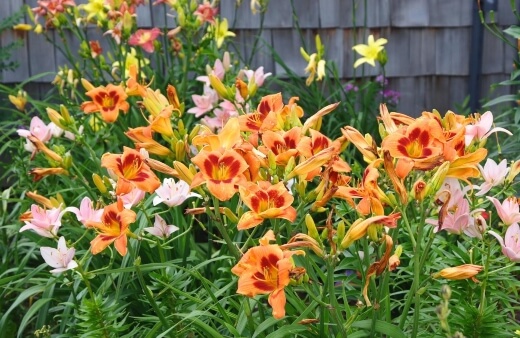
Genus: | Hemerocallis |
|---|---|
Family: | Asphodelaceae |
Plant Type: | Perennial |
Growth rate: | Maturity in 3 to 4 years |
Size: | 30 to 90 cm x 90 cm to 2,4 metres |
Sun requirements: | Full Sun |
Soil Type: | Slightly acidic to neutral |
Foliage Colour: | Orange, pink, purple, red, white, yellow |
Maintenance level: | Low |
Poisonous for pets: | Poisonous for pets: Yes, but only for cats |
Introducing Daylilies
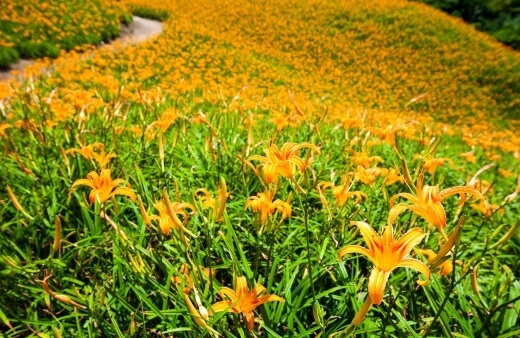
The day lily needs almost no maintenance which is good news for you. It’s easy to grow and doesn’t struggle much with diseases and pests. It can even survive drought, changing sunlight, and poor soil. Now that’s a robust plant worth having in the garden.
There are so many beautiful day lilies to choose from and they all have different blooming seasons. You might want to mix it up with a combination of early, mid-season and late blooming varieties. This means you can guarantee a floral spread across almost 3 seasons.
Features of the Hemerocallis
The name might confuse you but daylilies are not “true lilies”, as they grow from fleshy roots. True lilies grow from onion-like bulbs and are of the genus Lilium like the tiger lilies.
The leaves of the day lily grow from a crown and the flowers appear on a leafless stem. These stems are called scapes. Each scape will have between 12-15 buds on it, and a mature plant can have 4 to 6 scapes.
If you see a height listed next to a daylily variety, it’s referring to the length of the scape. Some of them can grow to a height of 1,8 metres.
Day lily flowers are sometimes fragrant and come in so many colours, shades, and colour combinations. Some of the flowers are full and round and some have wide petals with ruffled edges.
You get day lilies that are called “spiders” because they have a spider-like shape. You get varieties called “doubles” which have double the number of petals and sepals. There are even new cultivars that are night-blooming.
Day lily History
Day lilies are native to most of the Asian continent. By the 18th century, this lily travelled to Europe and soon became popular. European immigrants brought day lily tubers with them to the New World and the flowers established themselves by the early 1800s.
Uses of Daylilies
Daylilies are incredibly useful in addition to being low-maintenance and beautiful. Many of the varieties spread easily which means they are perfect as a colourful ground cover and for weed control.
The thick tubers of daylilies form an underground web that holds soil in place. Their thick roots spread out like fingers and keep a tight grip on soil, even on a steep slope.
You can use any variety of daylily as a soil stabiliser. For growing daylily in very steep slope, the tawny daylily, also known as Hemerocallis fulva, is the best option. This is the most widespread variety in the wild and can often be seen growing happily on road sides.
The botanical name of the day lily, Hemerocallis, comes from the Greek word hemera, which means “day” and kallos, which means “beauty”. The name seems to be perfectly chosen, as each flower lasts only one day.


Get Your Free Guide:
Master Growing Australian Natives eBook
A Must Have Complete Guide for Every Australian Garden
Get Your Free Guide:
Master Growing Australian Natives eBook
A Must Have Complete Guide for Every Australian Garden
Popular Daylilies to Grow in Your Home
Here are some of the day lily varieties:
Hemerocallis lilioasphodelus

This yellow day lily has warm yellow flowers, a sweet fragrance and grassy leaves. It would work perfectly as a border plant. Its size is 1m x 40cm.
Hemerocallis ‘Red Twister’
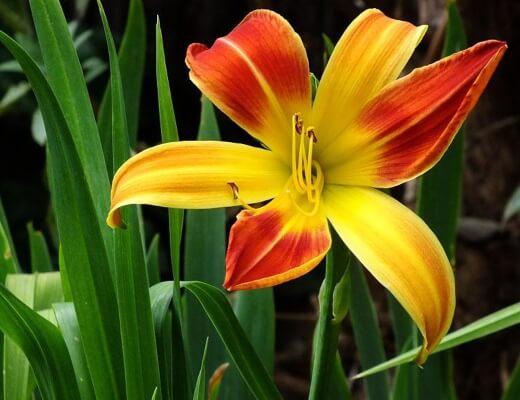
Source: garden.org
This variety has flowers that make you think of fire and they like to arrive in late summer. Think fiery blooms of red, orange and yellow.
This day lily variety is exotic looking, and would look great as an ornamental border, or even in a pot. In regions with mild climates, the leaves are evergreen. The size of this variety is 60cm x 45cm.
Hemerocallis ‘Henry D. Allnutt’

Source: gardenersworld.com
The Hemerocallis ‘Henry D. Allnutt’ variety is a hybrid of Hemerocallis ‘Dragon Pinata’ and Hemerocallis ‘Redneck Riviera’. The flowers are pale orange with a splash of crimson in the middle of the flower. This daylily grows to a size of 70cm x 50cm.
Hemerocallis ‘Piano Man’

The Hemerocallis ‘Piano Man’ daylily has fragrant cream flowers, with shades of plum and green. This variety produces many flowers for weeks on end. In milder regions the foliage is evergreen and the plant grows to a size of 60cm x 45cm.
Hemerocallis ‘Bela Lugosi’
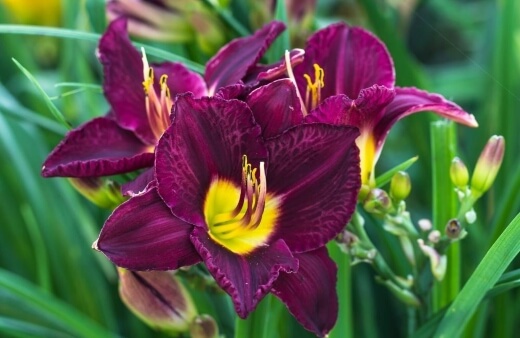
This daylily variety is full of drama. It is a deep purple-flowered variety and at the centre of the flowers you’ll see a brilliant yellow-green tone. This daylily is repeat flowering and grows to a size of 60cm x 45cm.
Hemerocallis ‘Ruby Spider’

Many of the day lily varieties are orange, but the Hemerocallis ‘Ruby Spider’ is a brilliant deep scarlet. Each petal has a bright yellow vein. This variety is also exotic looking, growing to a size of 80cm x 60cm.
Hemerocallis ‘Fleeting Fancy’

The large flowers of the ‘Fleeting Fancy’ daylily variety are a creamy orange colour and have red-brown markings towards the middle. This variety looks great combined with pink and purple-flowered plants like geraniums and agapanthus. Fleeting Fancy grows to a size of 50cm x 70cm.
Hemerocallis ‘Joan Senior’
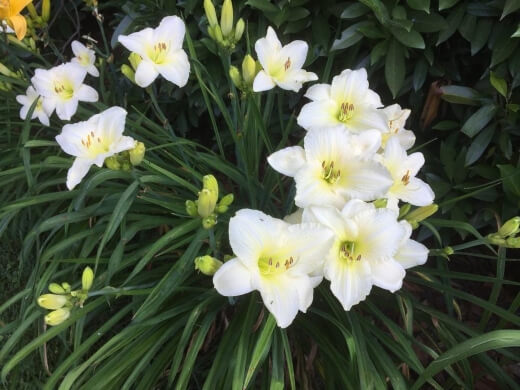
Source: garden.org
Hemerocallis ‘Joan Senior’ has soft cream flowers that become yellow as the plant matures. It flowers early and creates an abundance of flowers. It’s also easy to grow, and reaches a size of 75cm x 75cm.
Hemerocallis ‘Stafford’
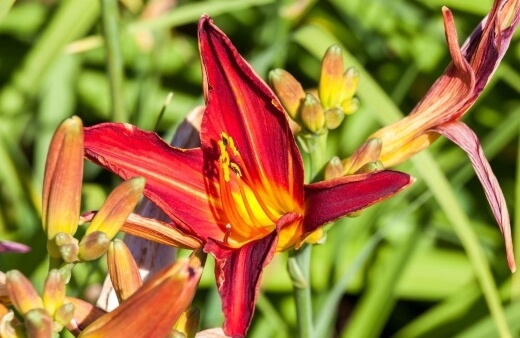
This daylily variety is very similar to the Hemerocallis ‘Ruby Spider’, but its flowers have a much deeper red colour and don’t have a yellow vein. This day lily can reach a size of 75cm x 45cm.
Hemerocallis lilioasphodelusThis yellow day lily has warm yellow flowers, a sweet fragrance and grassy leaves. It would work perfectly as a border plant. Its size is 1m x 40cm. |  |
Hemerocallis ‘Red Twister’This variety has flowers that make you think of fire and they like to arrive in late summer. Think fiery blooms of red, orange and yellow. This day lily variety is exotic looking, and would look great as an ornamental border, or even in a pot. In regions with mild climates, the leaves are evergreen. The size of this variety is 60cm x 45cm. |  Source: garden.org |
Hemerocallis ‘Henry D. Allnutt’The Hemerocallis ‘Henry D. Allnutt’ variety is a hybrid of Hemerocallis ‘Dragon Pinata’ and Hemerocallis ‘Redneck Riviera’. The flowers are pale orange with a splash of crimson in the middle of the flower. This daylily grows to a size of 70cm x 50cm. |  Source: gardenersworld.com |
Hemerocallis ‘Piano Man’The Hemerocallis ‘Piano Man’ daylily has fragrant cream flowers, with shades of plum and green. This variety produces many flowers for weeks on end. In milder regions the foliage is evergreen and the plant grows to a size of 60cm x 45cm. |  |
Hemerocallis ‘Bela Lugosi’This daylily variety is full of drama. It is a deep purple-flowered variety and at the centre of the flowers you’ll see a brilliant yellow-green tone. This daylily is repeat flowering and grows to a size of 60cm x 45cm. |  |
Hemerocallis ‘Ruby Spider’Many of the day lily varieties are orange, but the Hemerocallis ‘Ruby Spider’ is a brilliant deep scarlet. Each petal has a bright yellow vein. This variety is also exotic looking, growing to a size of 80cm x 60cm. |  |
Hemerocallis ‘Fleeting Fancy’The large flowers of the ‘Fleeting Fancy’ daylily variety are a creamy orange colour and have red-brown markings towards the middle. This variety looks great combined with pink and purple-flowered plants like geraniums and agapanthus. Fleeting Fancy grows to a size of 50cm x 70cm. |  |
Hemerocallis ‘Joan Senior’Hemerocallis ‘Joan Senior’ has soft cream flowers that become yellow as the plant matures. It flowers early and creates an abundance of flowers. It’s also easy to grow, and reaches a size of 75cm x 75cm. |  Source: garden.org |
Hemerocallis ‘Stafford’This daylily variety is very similar to the Hemerocallis ‘Ruby Spider’, but its flowers have a much deeper red colour and don’t have a yellow vein. This day lily can reach a size of 75cm x 45cm. |  |
How to Grow Daylily

Planting Daylilies
When to Plant
You want to plant daylilies in the spring as soon as you can work the soil. You could also plant them in early autumn, about 6 weeks before the first frost.
Choosing and Preparing a Planting Site
Day lilies can survive some tough conditions, but if you really want them to shine, give them full sun and plant them in well-drained, fertile soil.
Don’t plant them near trees and shrubs as these will compete for moisture and nutrients. You can increase the organic matter of the soil by adding aged manure or compost to the soil before planting.
How to Plant Daylilies
You will start off by digging a hole that is wide enough for the roots to spread out. The crown of the plant (which is where the roots and leaves meet) needs to be buried about 2.5 cm deep. You can then fill in the soil, lightly pressing it down around the plant and water until the soil is well saturated.
How to Propagate Daylilies

Propagating daylilies from seed allows for hybridization and day lilies cross pollinate very easily. Imagine growing your own hybrids from seed – you’ll end up with some very unique daylilies in your garden.
How to Cross Pollinate Day lily
To cross pollinate, you need to choose two parent plants that you would like to see combined. Using a cotton swab or a painter’s brush, you need to gently brush the pollen off the stamen of one plant’s flowers and place it on the pistil of another plant. There’s about a 50% chance that it will develop into a seed pod.
Harvesting Daylily Seeds
If the flower does produce a seed pod, you can let it dry naturally on the stem. When it turns brown and starts to split open, you can pick it and store it in a warm, dry place until you’re ready to plant. You can also plant the seed immediately.
Planting Daylily Seeds
Growing daylilies from seed is easy and they can be planted directly in the ground in most climates. You need moist soil with lots of added organic matter, and will then sow the seeds at a depth of 1.5-2 cm.
Make sure you keep the soil moist until seedlings appear. This usually takes 1 to 2 weeks. If you are starting out with the seeds indoors, you want to wait to transplant them in spring when any chance of frost has passed.
It can take 2 to 3 years for your new day lilies to produce flowers, but who knows what colours, shapes and patterns will appear in the new blooms you’ve created.
Caring for Daylily
Day lilies actually need very little care and will even survive if neglected. Of course you’re hoping to see these flowers thrive, so here’s some tips on how to give them the best care.

Watering Daylilies
You will need to water newly planted daylilies once a week until they become established. They are quite hardy and drought tolerant, which means they can go without watering.
In an ideal world, they would prefer about 2.5 cm of water per week. If your area experiences normal rainfall then the plant will be provided with the right amount of water without you needing to top up.
If there is a bit of a dry spell or you live in a dprier climate, you can water your day lilies. They will say thank you with many more blooms. You can also add mulch around the plant to keep it moist, and this helps to minimise weeding.
Need some help getting your watering routine just right? We’ve researched the 10 best irrigation and water systems for Australian gardens.
Fertiliser for Daylily
Day lilies don’t need fertilisation as long as the soil is quite fertile. If you want to encourage more flowers you can add a little general purpose fertiliser (10-10-10) once a year in early spring.
Spread a handful of the fertiliser at the base of each daylily clump and water it if dry. You can also fertilise day lilies a second time when they are finished blooming. This helps the plants to multiply faster next time around.
Pruning
Deadheading your day lily is not a must. You can just remove old flowers to prevent seed production and also to encourage more flowering. Just snip off their blooms when you see them wilting.
(Get the best pruning shears here in our 2023 product review and buying guide.)
Once all of the flowers have bloomed on a daylily flower stalk, you can cut the entire stalk back to the ground straight away or in autumn. If you do not cut it back (which is also perfectly fine), it will just turn brown and keep standing.
In early spring, it’s a good idea to remove the dead foliage from the previous year before new growth starts in the spring. You can also add aged manure or compost to the soil around the plants in the spring.
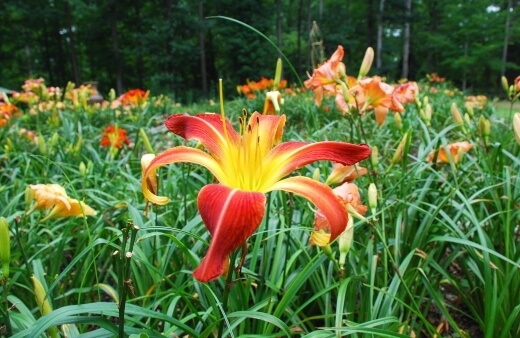
Dividing and Transplanting
Day lilies can spread quite aggressively which means they will need to be divided at some point. This is usually every 3 to 5 years. Dividing the plants gives it a fresh burst of energy, and this means better and more frequent flowers.
Here’s How to Divide Daylilies:
Dividing your day lilies can be done any time you are able to work the soil. It’s probably best to do it straight after the day lily has finished blooming. These plants need at least 6 weeks to establish themselves again before the winter.
You will begin by digging up the entire root clump. Remove as much soil from the roots as possible and then soak the roots in a bucket of water to get rid of excess soil. Next, you need to locate the crown of the plant.
Starting from the outer edge, you are going to break it into smaller clumps (usually 3 to 4 per plant). Each clump needs to have healthy roots and at least a few leaves.
Cut the leaves back to about one third of their original length. You can then replant the day lily and water well.
Common Daylily Diseases and Pests
The good news is that day lilies are usually quite stress free to grow. New shoots can become a snack for slugs and snails but the damage is minimal.
Hemerocallis gall midge is quite a new pest that can attack the early-flowering varieties of daylily. You might notice that the swollen flower buds don’t open, or the flowers could be distorted. You can pick off any distorted buds and throw them away.
Aphids and thrips sometimes feed on the flower buds. You can use insecticidal soap or strong sprays of water to keep them away.
If your daylily is suffering from poor flowering it might mean that your plant needs dividing. It can also be a sign that it’s growing in too much shade.
Daylily FAQs
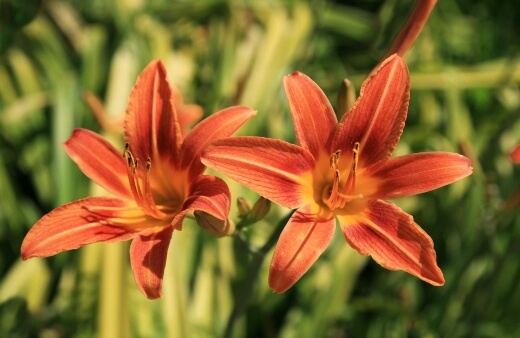
Can you eat the day lily?
All parts of the day lily can in fact be eaten. The tender leaves, buds and flowers can be eaten raw or in soups. The swollen portions of the root can also be boiled and eaten.
Day lilies actually have a long history in the kitchen. All parts of the plant have a mild peppery taste and help to thicken stews, soups, and sauces.
Some people like to sautée day lily buds in some butter and garlic, or you could dip them in a light batter and deep-fry them. They taste like a combination of green peas and asparagus.
Perhaps you’ll feel inspired by the day lily to create an outdoor kitchen.
Where is the day lily from?
The day lily is native to Asia, specifically eastern Asia, including China, Korea, and Japan. This genus is popular worldwide and there are over 80,000 registered cultivars.
What climate do daylilies grow in?
Day lilies are in fact one of the most adaptable flowering plants in the world – they are cold-hardy and heat-tolerant. They aren’t just adaptable when it comes to temperature – they can also survive and thrive in a variety of climates.
The day lily is the ideal choice for hot, dry climates, but also for cool, moist ones. If we want to talk about preferences, the dormant varieties of daylily do well in cold climates while the evergreens prefer a hot climate.
How big can a daylily grow?
Daylilies can range in height from 20cm to 1, 5 metres, and the flower size can be as small as 5cm or as large as 20cm. Day lilies can bloom the year that they are planted, even if the plant is small.
They reach their full size in about three to four years. These plants are able to live long if you give them sufficient care.
What does the day lily symbolise?
The day lily is a flower that symbolises motherhood, especially in China, where it means a mother’s devotion. Lilies are also the May birth flower, and the 30th wedding anniversary flower.
Is the day lily poisonous?
Every part of the day lily, from the flower to the stem, is poisonous to cats. Any other animal or human can eat the plant and they won’t have any reaction.
Can I use a day lily as a cut flower?
Daylilies make great cut flowers. Even though the individual flowers last just one day, the buds continue to develop and open for up to a week indoors.
The trick is to cut day lilies with buds that are just about to open. You’ll know this if you see just a bit of the flower colour showing. The buds higher up will start to open as the bottom ones fade.
Once you get the flowers inside, you want to quickly trim the stem ends, making a diagonal cut with a sharp knife. You should change the water every few days. If you remove the faded flowers daily, the new buds will open.
Looking for more lily plants for your garden? Check out our growing guides for Canna Lilies and Calla Lilies to see which suits your tastes.
Wrapping Up Our Daylilies Guide
The day lily is adaptable and low-maintenance, whilst beautiful and interesting. Whether you choose to spice up your garden with brilliant colour blooms, or fill a pretty vase with cut flowers, or perhaps even try out a daylily soup, you will find this plant has much to offer.
There is a day lily variety on offer for every gardener’s whim, and even though each bloom is just for a day, it will be a memorable one. We’re happy to give daylilies our very enthusiastic green thumbs up.
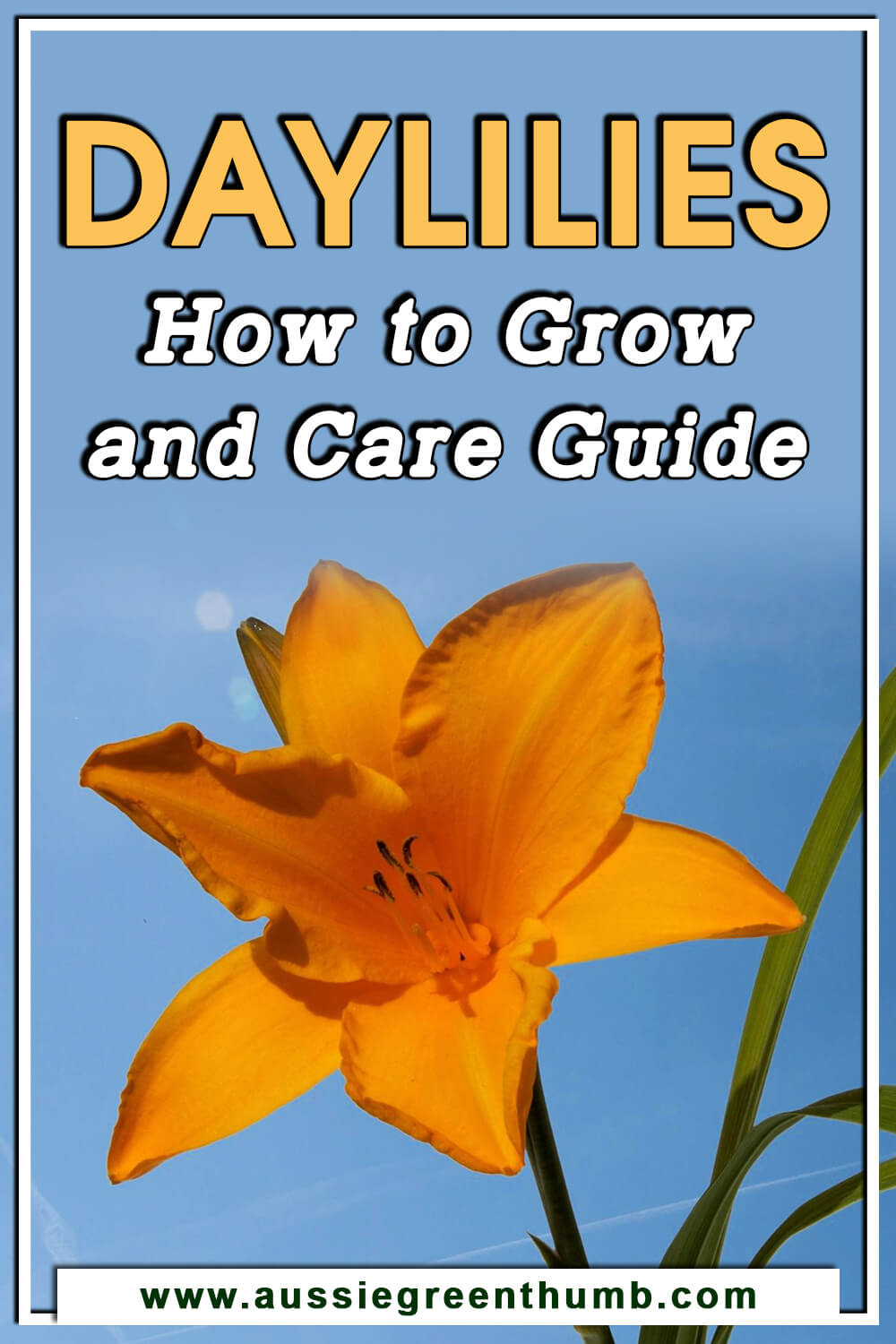
Published on March 27, 2022 by Maisie Blevins
Last Updated on September 20, 2024




